HR5053QA: Organisational Culture and Contemporary Firms Analysis
VerifiedAdded on 2023/06/07
|10
|2982
|351
Essay
AI Summary
This essay delves into the critical role of organisational culture within contemporary firms, examining its impact on both the organisation itself and its stakeholders. The introduction defines organisational culture and its importance in fostering employee motivation and achieving business goals. The main body analyses the cultural aspects of Marks and Spencer, Unilever, and Tesco, highlighting how these firms cultivate positive work environments and address diversity, employee well-being, and strategic management. The analysis includes how these companies have adapted their structures and strategies to improve their performance, discussing the implications of their decisions on their employees, customers, and overall business success. The conclusion summarizes the key findings and emphasizes the significance of a robust organisational culture in driving business performance and stakeholder satisfaction. The essay also draws on relevant theories and empirical evidence to support the arguments presented.
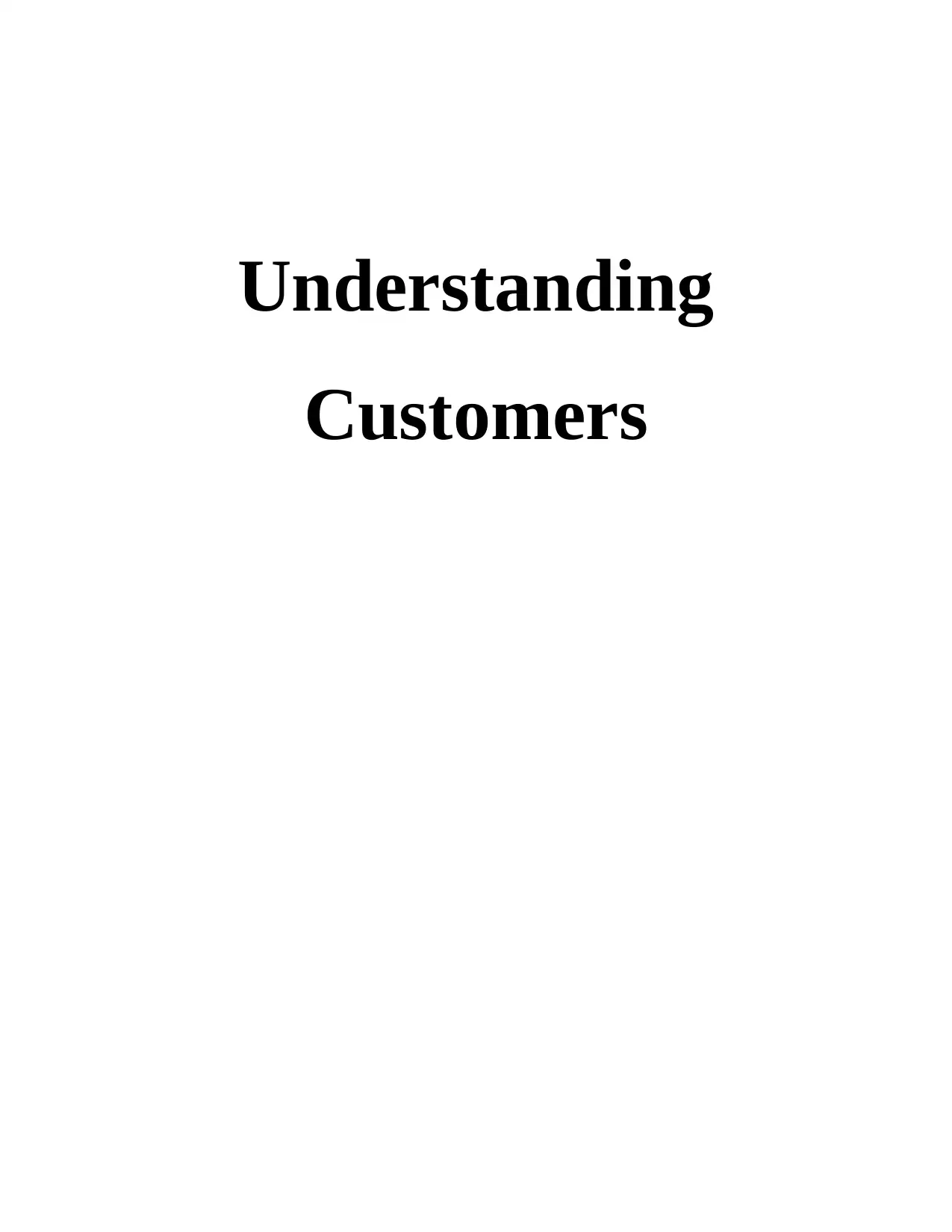
Understanding
Customers
Customers
Paraphrase This Document
Need a fresh take? Get an instant paraphrase of this document with our AI Paraphraser
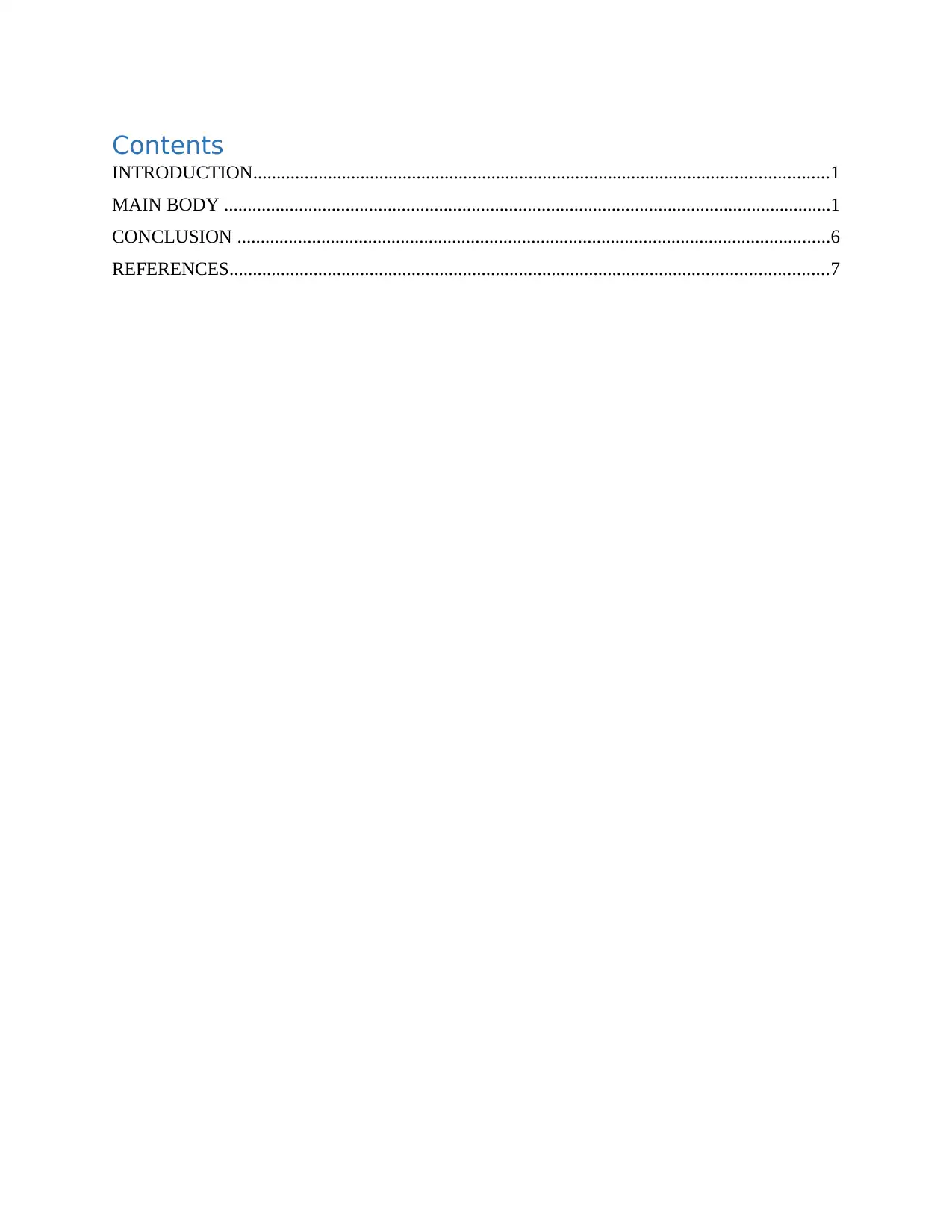
Contents
INTRODUCTION...........................................................................................................................1
MAIN BODY ..................................................................................................................................1
CONCLUSION ...............................................................................................................................6
REFERENCES................................................................................................................................7
INTRODUCTION...........................................................................................................................1
MAIN BODY ..................................................................................................................................1
CONCLUSION ...............................................................................................................................6
REFERENCES................................................................................................................................7
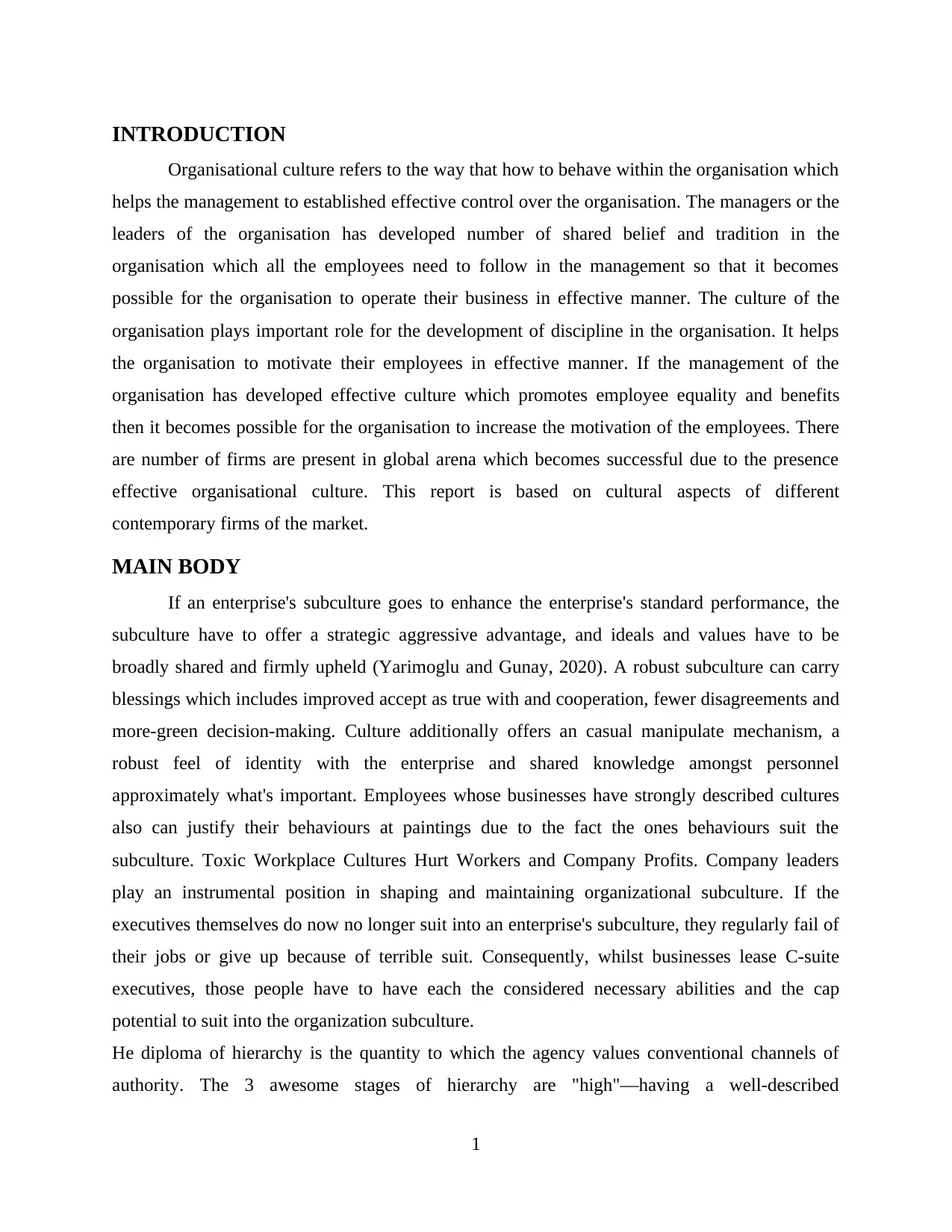
INTRODUCTION
Organisational culture refers to the way that how to behave within the organisation which
helps the management to established effective control over the organisation. The managers or the
leaders of the organisation has developed number of shared belief and tradition in the
organisation which all the employees need to follow in the management so that it becomes
possible for the organisation to operate their business in effective manner. The culture of the
organisation plays important role for the development of discipline in the organisation. It helps
the organisation to motivate their employees in effective manner. If the management of the
organisation has developed effective culture which promotes employee equality and benefits
then it becomes possible for the organisation to increase the motivation of the employees. There
are number of firms are present in global arena which becomes successful due to the presence
effective organisational culture. This report is based on cultural aspects of different
contemporary firms of the market.
MAIN BODY
If an enterprise's subculture goes to enhance the enterprise's standard performance, the
subculture have to offer a strategic aggressive advantage, and ideals and values have to be
broadly shared and firmly upheld (Yarimoglu and Gunay, 2020). A robust subculture can carry
blessings which includes improved accept as true with and cooperation, fewer disagreements and
more-green decision-making. Culture additionally offers an casual manipulate mechanism, a
robust feel of identity with the enterprise and shared knowledge amongst personnel
approximately what's important. Employees whose businesses have strongly described cultures
also can justify their behaviours at paintings due to the fact the ones behaviours suit the
subculture. Toxic Workplace Cultures Hurt Workers and Company Profits. Company leaders
play an instrumental position in shaping and maintaining organizational subculture. If the
executives themselves do now no longer suit into an enterprise's subculture, they regularly fail of
their jobs or give up because of terrible suit. Consequently, whilst businesses lease C-suite
executives, those people have to have each the considered necessary abilities and the cap
potential to suit into the organization subculture.
He diploma of hierarchy is the quantity to which the agency values conventional channels of
authority. The 3 awesome stages of hierarchy are "high"—having a well-described
1
Organisational culture refers to the way that how to behave within the organisation which
helps the management to established effective control over the organisation. The managers or the
leaders of the organisation has developed number of shared belief and tradition in the
organisation which all the employees need to follow in the management so that it becomes
possible for the organisation to operate their business in effective manner. The culture of the
organisation plays important role for the development of discipline in the organisation. It helps
the organisation to motivate their employees in effective manner. If the management of the
organisation has developed effective culture which promotes employee equality and benefits
then it becomes possible for the organisation to increase the motivation of the employees. There
are number of firms are present in global arena which becomes successful due to the presence
effective organisational culture. This report is based on cultural aspects of different
contemporary firms of the market.
MAIN BODY
If an enterprise's subculture goes to enhance the enterprise's standard performance, the
subculture have to offer a strategic aggressive advantage, and ideals and values have to be
broadly shared and firmly upheld (Yarimoglu and Gunay, 2020). A robust subculture can carry
blessings which includes improved accept as true with and cooperation, fewer disagreements and
more-green decision-making. Culture additionally offers an casual manipulate mechanism, a
robust feel of identity with the enterprise and shared knowledge amongst personnel
approximately what's important. Employees whose businesses have strongly described cultures
also can justify their behaviours at paintings due to the fact the ones behaviours suit the
subculture. Toxic Workplace Cultures Hurt Workers and Company Profits. Company leaders
play an instrumental position in shaping and maintaining organizational subculture. If the
executives themselves do now no longer suit into an enterprise's subculture, they regularly fail of
their jobs or give up because of terrible suit. Consequently, whilst businesses lease C-suite
executives, those people have to have each the considered necessary abilities and the cap
potential to suit into the organization subculture.
He diploma of hierarchy is the quantity to which the agency values conventional channels of
authority. The 3 awesome stages of hierarchy are "high"—having a well-described
1
⊘ This is a preview!⊘
Do you want full access?
Subscribe today to unlock all pages.

Trusted by 1+ million students worldwide
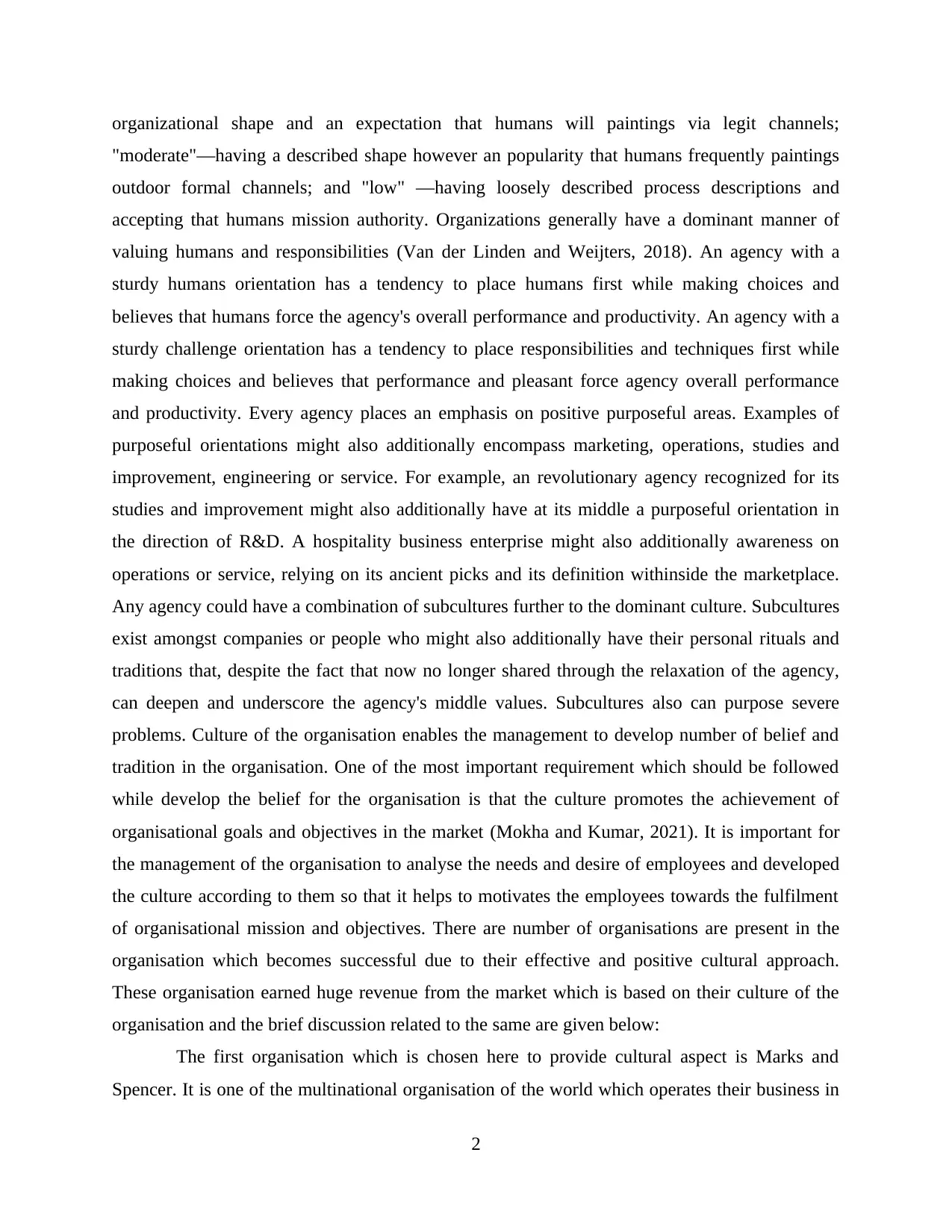
organizational shape and an expectation that humans will paintings via legit channels;
"moderate"—having a described shape however an popularity that humans frequently paintings
outdoor formal channels; and "low" —having loosely described process descriptions and
accepting that humans mission authority. Organizations generally have a dominant manner of
valuing humans and responsibilities (Van der Linden and Weijters, 2018). An agency with a
sturdy humans orientation has a tendency to place humans first while making choices and
believes that humans force the agency's overall performance and productivity. An agency with a
sturdy challenge orientation has a tendency to place responsibilities and techniques first while
making choices and believes that performance and pleasant force agency overall performance
and productivity. Every agency places an emphasis on positive purposeful areas. Examples of
purposeful orientations might also additionally encompass marketing, operations, studies and
improvement, engineering or service. For example, an revolutionary agency recognized for its
studies and improvement might also additionally have at its middle a purposeful orientation in
the direction of R&D. A hospitality business enterprise might also additionally awareness on
operations or service, relying on its ancient picks and its definition withinside the marketplace.
Any agency could have a combination of subcultures further to the dominant culture. Subcultures
exist amongst companies or people who might also additionally have their personal rituals and
traditions that, despite the fact that now no longer shared through the relaxation of the agency,
can deepen and underscore the agency's middle values. Subcultures also can purpose severe
problems. Culture of the organisation enables the management to develop number of belief and
tradition in the organisation. One of the most important requirement which should be followed
while develop the belief for the organisation is that the culture promotes the achievement of
organisational goals and objectives in the market (Mokha and Kumar, 2021). It is important for
the management of the organisation to analyse the needs and desire of employees and developed
the culture according to them so that it helps to motivates the employees towards the fulfilment
of organisational mission and objectives. There are number of organisations are present in the
organisation which becomes successful due to their effective and positive cultural approach.
These organisation earned huge revenue from the market which is based on their culture of the
organisation and the brief discussion related to the same are given below:
The first organisation which is chosen here to provide cultural aspect is Marks and
Spencer. It is one of the multinational organisation of the world which operates their business in
2
"moderate"—having a described shape however an popularity that humans frequently paintings
outdoor formal channels; and "low" —having loosely described process descriptions and
accepting that humans mission authority. Organizations generally have a dominant manner of
valuing humans and responsibilities (Van der Linden and Weijters, 2018). An agency with a
sturdy humans orientation has a tendency to place humans first while making choices and
believes that humans force the agency's overall performance and productivity. An agency with a
sturdy challenge orientation has a tendency to place responsibilities and techniques first while
making choices and believes that performance and pleasant force agency overall performance
and productivity. Every agency places an emphasis on positive purposeful areas. Examples of
purposeful orientations might also additionally encompass marketing, operations, studies and
improvement, engineering or service. For example, an revolutionary agency recognized for its
studies and improvement might also additionally have at its middle a purposeful orientation in
the direction of R&D. A hospitality business enterprise might also additionally awareness on
operations or service, relying on its ancient picks and its definition withinside the marketplace.
Any agency could have a combination of subcultures further to the dominant culture. Subcultures
exist amongst companies or people who might also additionally have their personal rituals and
traditions that, despite the fact that now no longer shared through the relaxation of the agency,
can deepen and underscore the agency's middle values. Subcultures also can purpose severe
problems. Culture of the organisation enables the management to develop number of belief and
tradition in the organisation. One of the most important requirement which should be followed
while develop the belief for the organisation is that the culture promotes the achievement of
organisational goals and objectives in the market (Mokha and Kumar, 2021). It is important for
the management of the organisation to analyse the needs and desire of employees and developed
the culture according to them so that it helps to motivates the employees towards the fulfilment
of organisational mission and objectives. There are number of organisations are present in the
organisation which becomes successful due to their effective and positive cultural approach.
These organisation earned huge revenue from the market which is based on their culture of the
organisation and the brief discussion related to the same are given below:
The first organisation which is chosen here to provide cultural aspect is Marks and
Spencer. It is one of the multinational organisation of the world which operates their business in
2
Paraphrase This Document
Need a fresh take? Get an instant paraphrase of this document with our AI Paraphraser
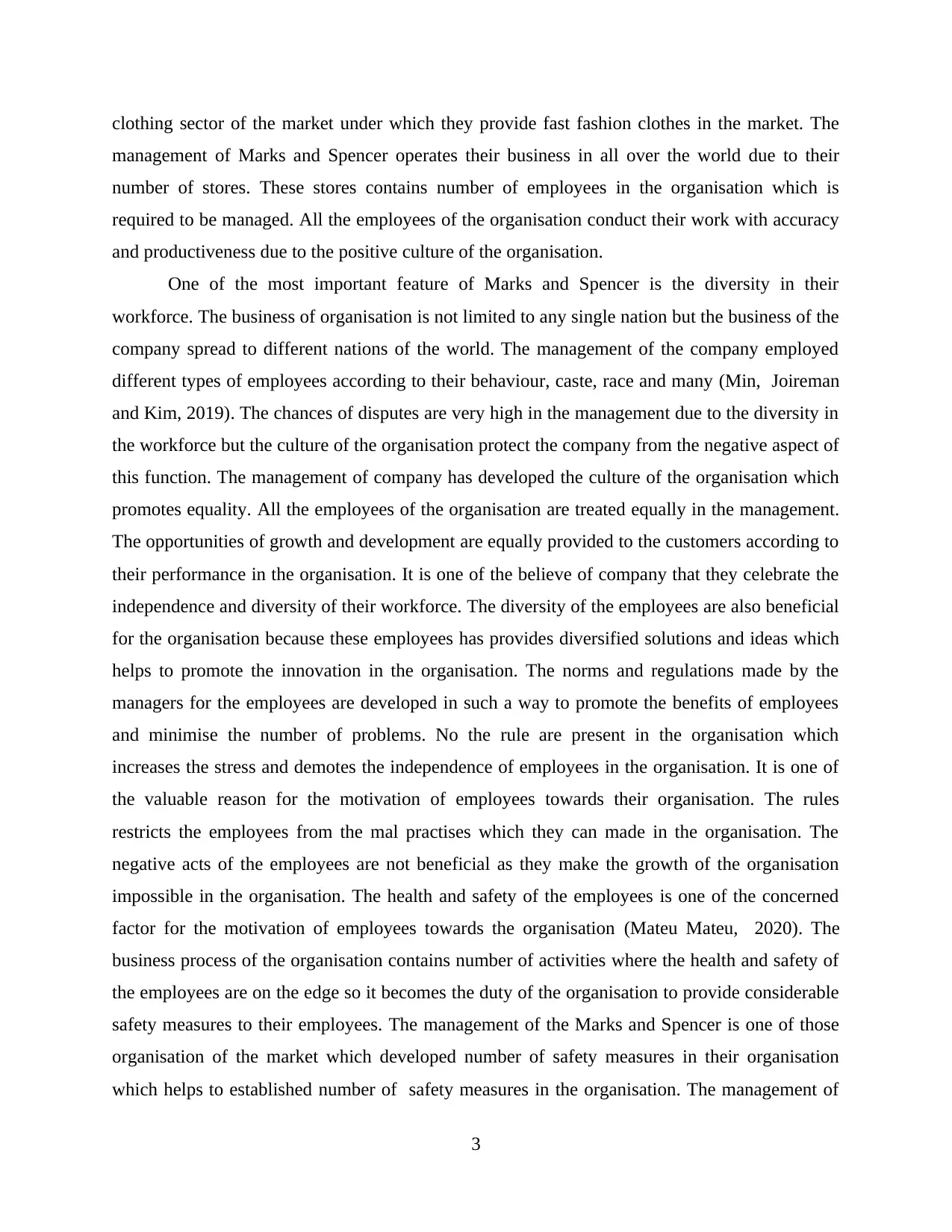
clothing sector of the market under which they provide fast fashion clothes in the market. The
management of Marks and Spencer operates their business in all over the world due to their
number of stores. These stores contains number of employees in the organisation which is
required to be managed. All the employees of the organisation conduct their work with accuracy
and productiveness due to the positive culture of the organisation.
One of the most important feature of Marks and Spencer is the diversity in their
workforce. The business of organisation is not limited to any single nation but the business of the
company spread to different nations of the world. The management of the company employed
different types of employees according to their behaviour, caste, race and many (Min, Joireman
and Kim, 2019). The chances of disputes are very high in the management due to the diversity in
the workforce but the culture of the organisation protect the company from the negative aspect of
this function. The management of company has developed the culture of the organisation which
promotes equality. All the employees of the organisation are treated equally in the management.
The opportunities of growth and development are equally provided to the customers according to
their performance in the organisation. It is one of the believe of company that they celebrate the
independence and diversity of their workforce. The diversity of the employees are also beneficial
for the organisation because these employees has provides diversified solutions and ideas which
helps to promote the innovation in the organisation. The norms and regulations made by the
managers for the employees are developed in such a way to promote the benefits of employees
and minimise the number of problems. No the rule are present in the organisation which
increases the stress and demotes the independence of employees in the organisation. It is one of
the valuable reason for the motivation of employees towards their organisation. The rules
restricts the employees from the mal practises which they can made in the organisation. The
negative acts of the employees are not beneficial as they make the growth of the organisation
impossible in the organisation. The health and safety of the employees is one of the concerned
factor for the motivation of employees towards the organisation (Mateu Mateu, 2020). The
business process of the organisation contains number of activities where the health and safety of
the employees are on the edge so it becomes the duty of the organisation to provide considerable
safety measures to their employees. The management of the Marks and Spencer is one of those
organisation of the market which developed number of safety measures in their organisation
which helps to established number of safety measures in the organisation. The management of
3
management of Marks and Spencer operates their business in all over the world due to their
number of stores. These stores contains number of employees in the organisation which is
required to be managed. All the employees of the organisation conduct their work with accuracy
and productiveness due to the positive culture of the organisation.
One of the most important feature of Marks and Spencer is the diversity in their
workforce. The business of organisation is not limited to any single nation but the business of the
company spread to different nations of the world. The management of the company employed
different types of employees according to their behaviour, caste, race and many (Min, Joireman
and Kim, 2019). The chances of disputes are very high in the management due to the diversity in
the workforce but the culture of the organisation protect the company from the negative aspect of
this function. The management of company has developed the culture of the organisation which
promotes equality. All the employees of the organisation are treated equally in the management.
The opportunities of growth and development are equally provided to the customers according to
their performance in the organisation. It is one of the believe of company that they celebrate the
independence and diversity of their workforce. The diversity of the employees are also beneficial
for the organisation because these employees has provides diversified solutions and ideas which
helps to promote the innovation in the organisation. The norms and regulations made by the
managers for the employees are developed in such a way to promote the benefits of employees
and minimise the number of problems. No the rule are present in the organisation which
increases the stress and demotes the independence of employees in the organisation. It is one of
the valuable reason for the motivation of employees towards their organisation. The rules
restricts the employees from the mal practises which they can made in the organisation. The
negative acts of the employees are not beneficial as they make the growth of the organisation
impossible in the organisation. The health and safety of the employees is one of the concerned
factor for the motivation of employees towards the organisation (Mateu Mateu, 2020). The
business process of the organisation contains number of activities where the health and safety of
the employees are on the edge so it becomes the duty of the organisation to provide considerable
safety measures to their employees. The management of the Marks and Spencer is one of those
organisation of the market which developed number of safety measures in their organisation
which helps to established number of safety measures in the organisation. The management of
3
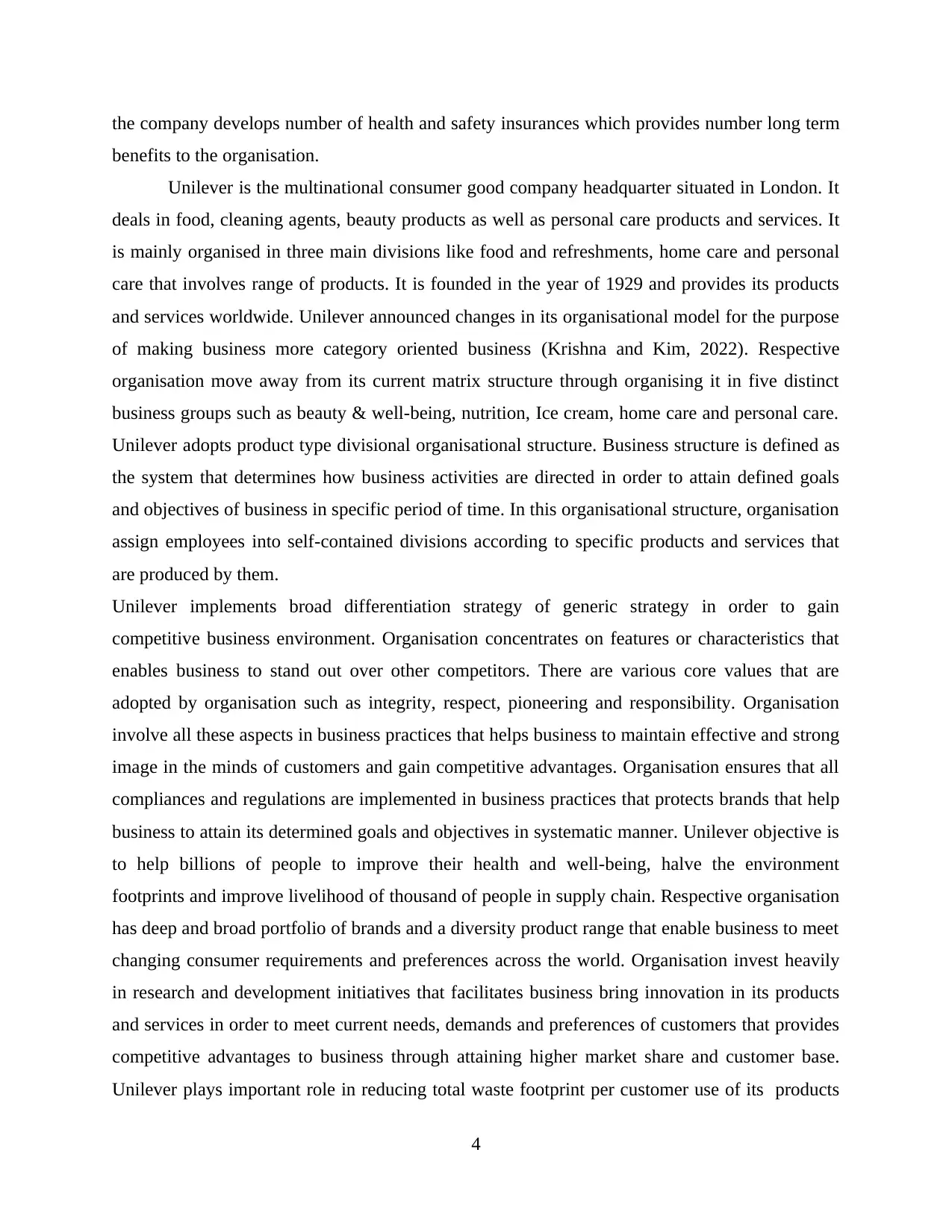
the company develops number of health and safety insurances which provides number long term
benefits to the organisation.
Unilever is the multinational consumer good company headquarter situated in London. It
deals in food, cleaning agents, beauty products as well as personal care products and services. It
is mainly organised in three main divisions like food and refreshments, home care and personal
care that involves range of products. It is founded in the year of 1929 and provides its products
and services worldwide. Unilever announced changes in its organisational model for the purpose
of making business more category oriented business (Krishna and Kim, 2022). Respective
organisation move away from its current matrix structure through organising it in five distinct
business groups such as beauty & well-being, nutrition, Ice cream, home care and personal care.
Unilever adopts product type divisional organisational structure. Business structure is defined as
the system that determines how business activities are directed in order to attain defined goals
and objectives of business in specific period of time. In this organisational structure, organisation
assign employees into self-contained divisions according to specific products and services that
are produced by them.
Unilever implements broad differentiation strategy of generic strategy in order to gain
competitive business environment. Organisation concentrates on features or characteristics that
enables business to stand out over other competitors. There are various core values that are
adopted by organisation such as integrity, respect, pioneering and responsibility. Organisation
involve all these aspects in business practices that helps business to maintain effective and strong
image in the minds of customers and gain competitive advantages. Organisation ensures that all
compliances and regulations are implemented in business practices that protects brands that help
business to attain its determined goals and objectives in systematic manner. Unilever objective is
to help billions of people to improve their health and well-being, halve the environment
footprints and improve livelihood of thousand of people in supply chain. Respective organisation
has deep and broad portfolio of brands and a diversity product range that enable business to meet
changing consumer requirements and preferences across the world. Organisation invest heavily
in research and development initiatives that facilitates business bring innovation in its products
and services in order to meet current needs, demands and preferences of customers that provides
competitive advantages to business through attaining higher market share and customer base.
Unilever plays important role in reducing total waste footprint per customer use of its products
4
benefits to the organisation.
Unilever is the multinational consumer good company headquarter situated in London. It
deals in food, cleaning agents, beauty products as well as personal care products and services. It
is mainly organised in three main divisions like food and refreshments, home care and personal
care that involves range of products. It is founded in the year of 1929 and provides its products
and services worldwide. Unilever announced changes in its organisational model for the purpose
of making business more category oriented business (Krishna and Kim, 2022). Respective
organisation move away from its current matrix structure through organising it in five distinct
business groups such as beauty & well-being, nutrition, Ice cream, home care and personal care.
Unilever adopts product type divisional organisational structure. Business structure is defined as
the system that determines how business activities are directed in order to attain defined goals
and objectives of business in specific period of time. In this organisational structure, organisation
assign employees into self-contained divisions according to specific products and services that
are produced by them.
Unilever implements broad differentiation strategy of generic strategy in order to gain
competitive business environment. Organisation concentrates on features or characteristics that
enables business to stand out over other competitors. There are various core values that are
adopted by organisation such as integrity, respect, pioneering and responsibility. Organisation
involve all these aspects in business practices that helps business to maintain effective and strong
image in the minds of customers and gain competitive advantages. Organisation ensures that all
compliances and regulations are implemented in business practices that protects brands that help
business to attain its determined goals and objectives in systematic manner. Unilever objective is
to help billions of people to improve their health and well-being, halve the environment
footprints and improve livelihood of thousand of people in supply chain. Respective organisation
has deep and broad portfolio of brands and a diversity product range that enable business to meet
changing consumer requirements and preferences across the world. Organisation invest heavily
in research and development initiatives that facilitates business bring innovation in its products
and services in order to meet current needs, demands and preferences of customers that provides
competitive advantages to business through attaining higher market share and customer base.
Unilever plays important role in reducing total waste footprint per customer use of its products
4
⊘ This is a preview!⊘
Do you want full access?
Subscribe today to unlock all pages.

Trusted by 1+ million students worldwide
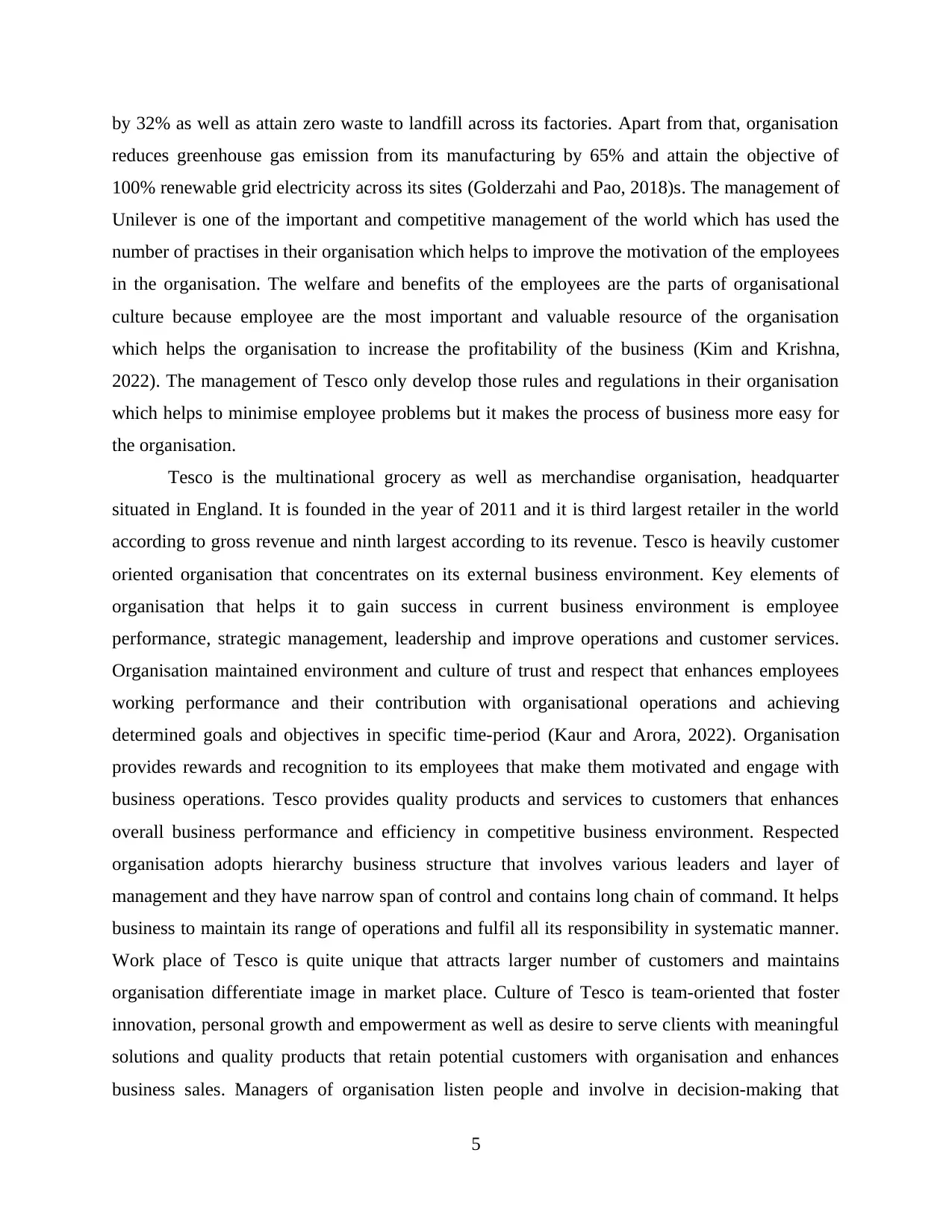
by 32% as well as attain zero waste to landfill across its factories. Apart from that, organisation
reduces greenhouse gas emission from its manufacturing by 65% and attain the objective of
100% renewable grid electricity across its sites (Golderzahi and Pao, 2018)s. The management of
Unilever is one of the important and competitive management of the world which has used the
number of practises in their organisation which helps to improve the motivation of the employees
in the organisation. The welfare and benefits of the employees are the parts of organisational
culture because employee are the most important and valuable resource of the organisation
which helps the organisation to increase the profitability of the business (Kim and Krishna,
2022). The management of Tesco only develop those rules and regulations in their organisation
which helps to minimise employee problems but it makes the process of business more easy for
the organisation.
Tesco is the multinational grocery as well as merchandise organisation, headquarter
situated in England. It is founded in the year of 2011 and it is third largest retailer in the world
according to gross revenue and ninth largest according to its revenue. Tesco is heavily customer
oriented organisation that concentrates on its external business environment. Key elements of
organisation that helps it to gain success in current business environment is employee
performance, strategic management, leadership and improve operations and customer services.
Organisation maintained environment and culture of trust and respect that enhances employees
working performance and their contribution with organisational operations and achieving
determined goals and objectives in specific time-period (Kaur and Arora, 2022). Organisation
provides rewards and recognition to its employees that make them motivated and engage with
business operations. Tesco provides quality products and services to customers that enhances
overall business performance and efficiency in competitive business environment. Respected
organisation adopts hierarchy business structure that involves various leaders and layer of
management and they have narrow span of control and contains long chain of command. It helps
business to maintain its range of operations and fulfil all its responsibility in systematic manner.
Work place of Tesco is quite unique that attracts larger number of customers and maintains
organisation differentiate image in market place. Culture of Tesco is team-oriented that foster
innovation, personal growth and empowerment as well as desire to serve clients with meaningful
solutions and quality products that retain potential customers with organisation and enhances
business sales. Managers of organisation listen people and involve in decision-making that
5
reduces greenhouse gas emission from its manufacturing by 65% and attain the objective of
100% renewable grid electricity across its sites (Golderzahi and Pao, 2018)s. The management of
Unilever is one of the important and competitive management of the world which has used the
number of practises in their organisation which helps to improve the motivation of the employees
in the organisation. The welfare and benefits of the employees are the parts of organisational
culture because employee are the most important and valuable resource of the organisation
which helps the organisation to increase the profitability of the business (Kim and Krishna,
2022). The management of Tesco only develop those rules and regulations in their organisation
which helps to minimise employee problems but it makes the process of business more easy for
the organisation.
Tesco is the multinational grocery as well as merchandise organisation, headquarter
situated in England. It is founded in the year of 2011 and it is third largest retailer in the world
according to gross revenue and ninth largest according to its revenue. Tesco is heavily customer
oriented organisation that concentrates on its external business environment. Key elements of
organisation that helps it to gain success in current business environment is employee
performance, strategic management, leadership and improve operations and customer services.
Organisation maintained environment and culture of trust and respect that enhances employees
working performance and their contribution with organisational operations and achieving
determined goals and objectives in specific time-period (Kaur and Arora, 2022). Organisation
provides rewards and recognition to its employees that make them motivated and engage with
business operations. Tesco provides quality products and services to customers that enhances
overall business performance and efficiency in competitive business environment. Respected
organisation adopts hierarchy business structure that involves various leaders and layer of
management and they have narrow span of control and contains long chain of command. It helps
business to maintain its range of operations and fulfil all its responsibility in systematic manner.
Work place of Tesco is quite unique that attracts larger number of customers and maintains
organisation differentiate image in market place. Culture of Tesco is team-oriented that foster
innovation, personal growth and empowerment as well as desire to serve clients with meaningful
solutions and quality products that retain potential customers with organisation and enhances
business sales. Managers of organisation listen people and involve in decision-making that
5
Paraphrase This Document
Need a fresh take? Get an instant paraphrase of this document with our AI Paraphraser
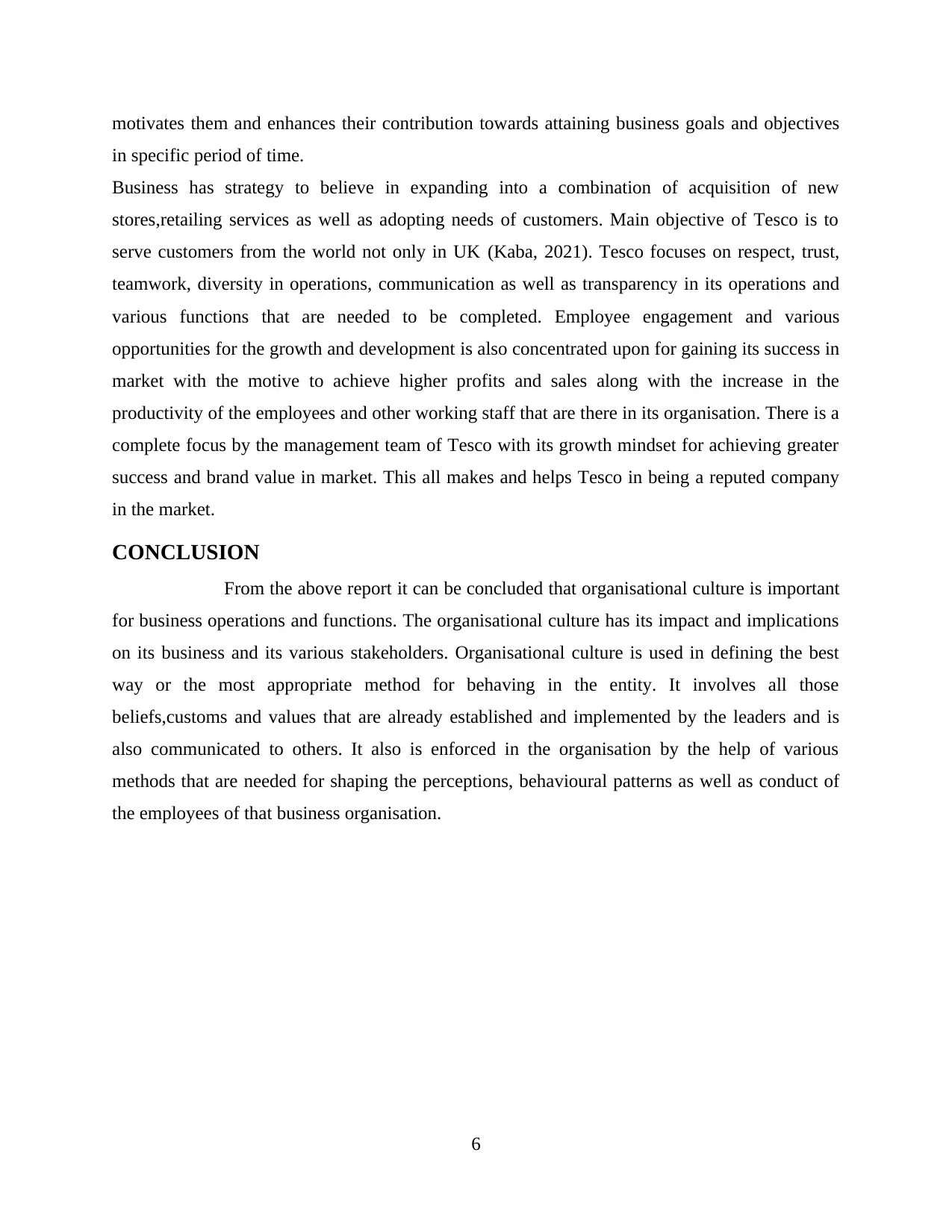
motivates them and enhances their contribution towards attaining business goals and objectives
in specific period of time.
Business has strategy to believe in expanding into a combination of acquisition of new
stores,retailing services as well as adopting needs of customers. Main objective of Tesco is to
serve customers from the world not only in UK (Kaba, 2021). Tesco focuses on respect, trust,
teamwork, diversity in operations, communication as well as transparency in its operations and
various functions that are needed to be completed. Employee engagement and various
opportunities for the growth and development is also concentrated upon for gaining its success in
market with the motive to achieve higher profits and sales along with the increase in the
productivity of the employees and other working staff that are there in its organisation. There is a
complete focus by the management team of Tesco with its growth mindset for achieving greater
success and brand value in market. This all makes and helps Tesco in being a reputed company
in the market.
CONCLUSION
From the above report it can be concluded that organisational culture is important
for business operations and functions. The organisational culture has its impact and implications
on its business and its various stakeholders. Organisational culture is used in defining the best
way or the most appropriate method for behaving in the entity. It involves all those
beliefs,customs and values that are already established and implemented by the leaders and is
also communicated to others. It also is enforced in the organisation by the help of various
methods that are needed for shaping the perceptions, behavioural patterns as well as conduct of
the employees of that business organisation.
6
in specific period of time.
Business has strategy to believe in expanding into a combination of acquisition of new
stores,retailing services as well as adopting needs of customers. Main objective of Tesco is to
serve customers from the world not only in UK (Kaba, 2021). Tesco focuses on respect, trust,
teamwork, diversity in operations, communication as well as transparency in its operations and
various functions that are needed to be completed. Employee engagement and various
opportunities for the growth and development is also concentrated upon for gaining its success in
market with the motive to achieve higher profits and sales along with the increase in the
productivity of the employees and other working staff that are there in its organisation. There is a
complete focus by the management team of Tesco with its growth mindset for achieving greater
success and brand value in market. This all makes and helps Tesco in being a reputed company
in the market.
CONCLUSION
From the above report it can be concluded that organisational culture is important
for business operations and functions. The organisational culture has its impact and implications
on its business and its various stakeholders. Organisational culture is used in defining the best
way or the most appropriate method for behaving in the entity. It involves all those
beliefs,customs and values that are already established and implemented by the leaders and is
also communicated to others. It also is enforced in the organisation by the help of various
methods that are needed for shaping the perceptions, behavioural patterns as well as conduct of
the employees of that business organisation.
6
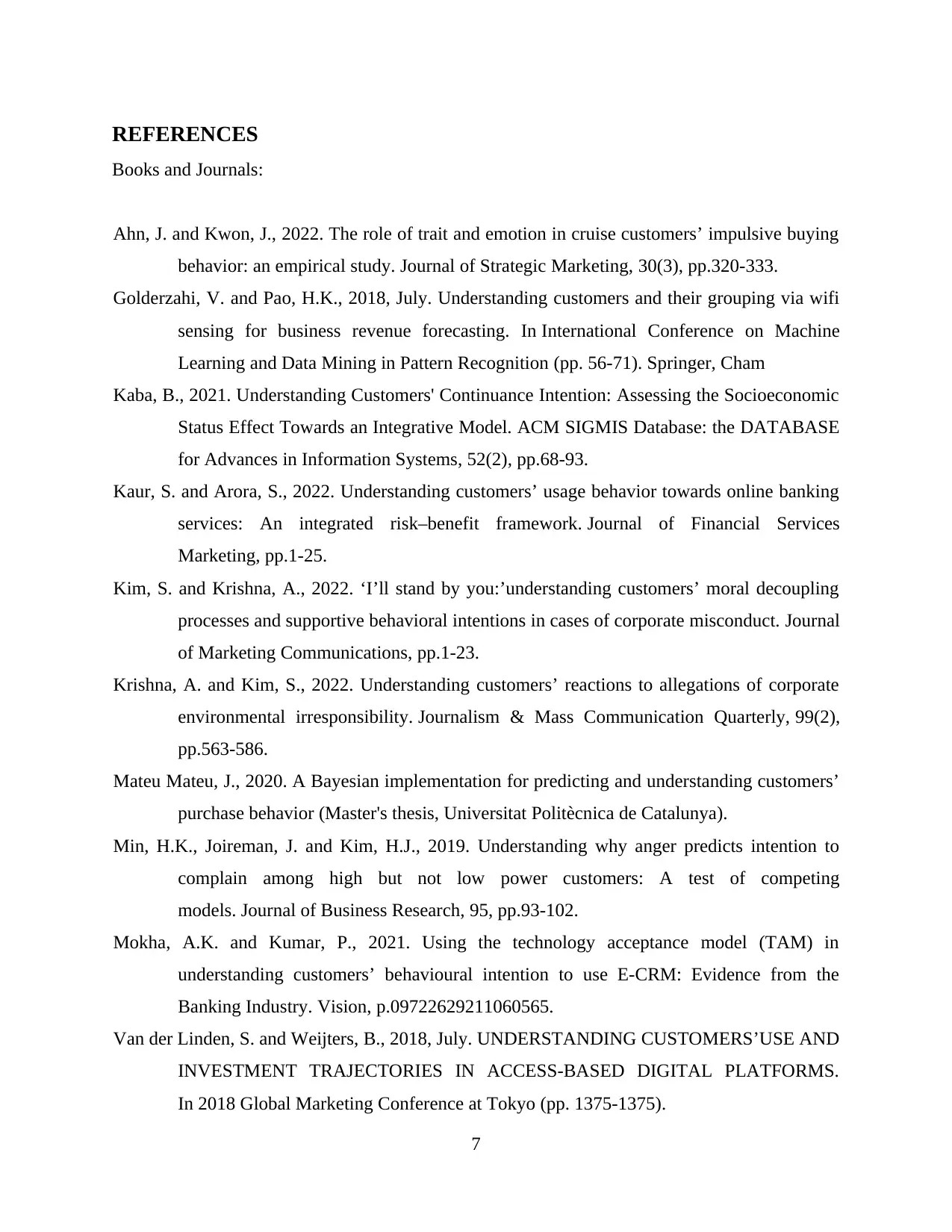
REFERENCES
Books and Journals:
Ahn, J. and Kwon, J., 2022. The role of trait and emotion in cruise customers’ impulsive buying
behavior: an empirical study. Journal of Strategic Marketing, 30(3), pp.320-333.
Golderzahi, V. and Pao, H.K., 2018, July. Understanding customers and their grouping via wifi
sensing for business revenue forecasting. In International Conference on Machine
Learning and Data Mining in Pattern Recognition (pp. 56-71). Springer, Cham
Kaba, B., 2021. Understanding Customers' Continuance Intention: Assessing the Socioeconomic
Status Effect Towards an Integrative Model. ACM SIGMIS Database: the DATABASE
for Advances in Information Systems, 52(2), pp.68-93.
Kaur, S. and Arora, S., 2022. Understanding customers’ usage behavior towards online banking
services: An integrated risk–benefit framework. Journal of Financial Services
Marketing, pp.1-25.
Kim, S. and Krishna, A., 2022. ‘I’ll stand by you:’understanding customers’ moral decoupling
processes and supportive behavioral intentions in cases of corporate misconduct. Journal
of Marketing Communications, pp.1-23.
Krishna, A. and Kim, S., 2022. Understanding customers’ reactions to allegations of corporate
environmental irresponsibility. Journalism & Mass Communication Quarterly, 99(2),
pp.563-586.
Mateu Mateu, J., 2020. A Bayesian implementation for predicting and understanding customers’
purchase behavior (Master's thesis, Universitat Politècnica de Catalunya).
Min, H.K., Joireman, J. and Kim, H.J., 2019. Understanding why anger predicts intention to
complain among high but not low power customers: A test of competing
models. Journal of Business Research, 95, pp.93-102.
Mokha, A.K. and Kumar, P., 2021. Using the technology acceptance model (TAM) in
understanding customers’ behavioural intention to use E-CRM: Evidence from the
Banking Industry. Vision, p.09722629211060565.
Van der Linden, S. and Weijters, B., 2018, July. UNDERSTANDING CUSTOMERS’USE AND
INVESTMENT TRAJECTORIES IN ACCESS-BASED DIGITAL PLATFORMS.
In 2018 Global Marketing Conference at Tokyo (pp. 1375-1375).
7
Books and Journals:
Ahn, J. and Kwon, J., 2022. The role of trait and emotion in cruise customers’ impulsive buying
behavior: an empirical study. Journal of Strategic Marketing, 30(3), pp.320-333.
Golderzahi, V. and Pao, H.K., 2018, July. Understanding customers and their grouping via wifi
sensing for business revenue forecasting. In International Conference on Machine
Learning and Data Mining in Pattern Recognition (pp. 56-71). Springer, Cham
Kaba, B., 2021. Understanding Customers' Continuance Intention: Assessing the Socioeconomic
Status Effect Towards an Integrative Model. ACM SIGMIS Database: the DATABASE
for Advances in Information Systems, 52(2), pp.68-93.
Kaur, S. and Arora, S., 2022. Understanding customers’ usage behavior towards online banking
services: An integrated risk–benefit framework. Journal of Financial Services
Marketing, pp.1-25.
Kim, S. and Krishna, A., 2022. ‘I’ll stand by you:’understanding customers’ moral decoupling
processes and supportive behavioral intentions in cases of corporate misconduct. Journal
of Marketing Communications, pp.1-23.
Krishna, A. and Kim, S., 2022. Understanding customers’ reactions to allegations of corporate
environmental irresponsibility. Journalism & Mass Communication Quarterly, 99(2),
pp.563-586.
Mateu Mateu, J., 2020. A Bayesian implementation for predicting and understanding customers’
purchase behavior (Master's thesis, Universitat Politècnica de Catalunya).
Min, H.K., Joireman, J. and Kim, H.J., 2019. Understanding why anger predicts intention to
complain among high but not low power customers: A test of competing
models. Journal of Business Research, 95, pp.93-102.
Mokha, A.K. and Kumar, P., 2021. Using the technology acceptance model (TAM) in
understanding customers’ behavioural intention to use E-CRM: Evidence from the
Banking Industry. Vision, p.09722629211060565.
Van der Linden, S. and Weijters, B., 2018, July. UNDERSTANDING CUSTOMERS’USE AND
INVESTMENT TRAJECTORIES IN ACCESS-BASED DIGITAL PLATFORMS.
In 2018 Global Marketing Conference at Tokyo (pp. 1375-1375).
7
⊘ This is a preview!⊘
Do you want full access?
Subscribe today to unlock all pages.

Trusted by 1+ million students worldwide
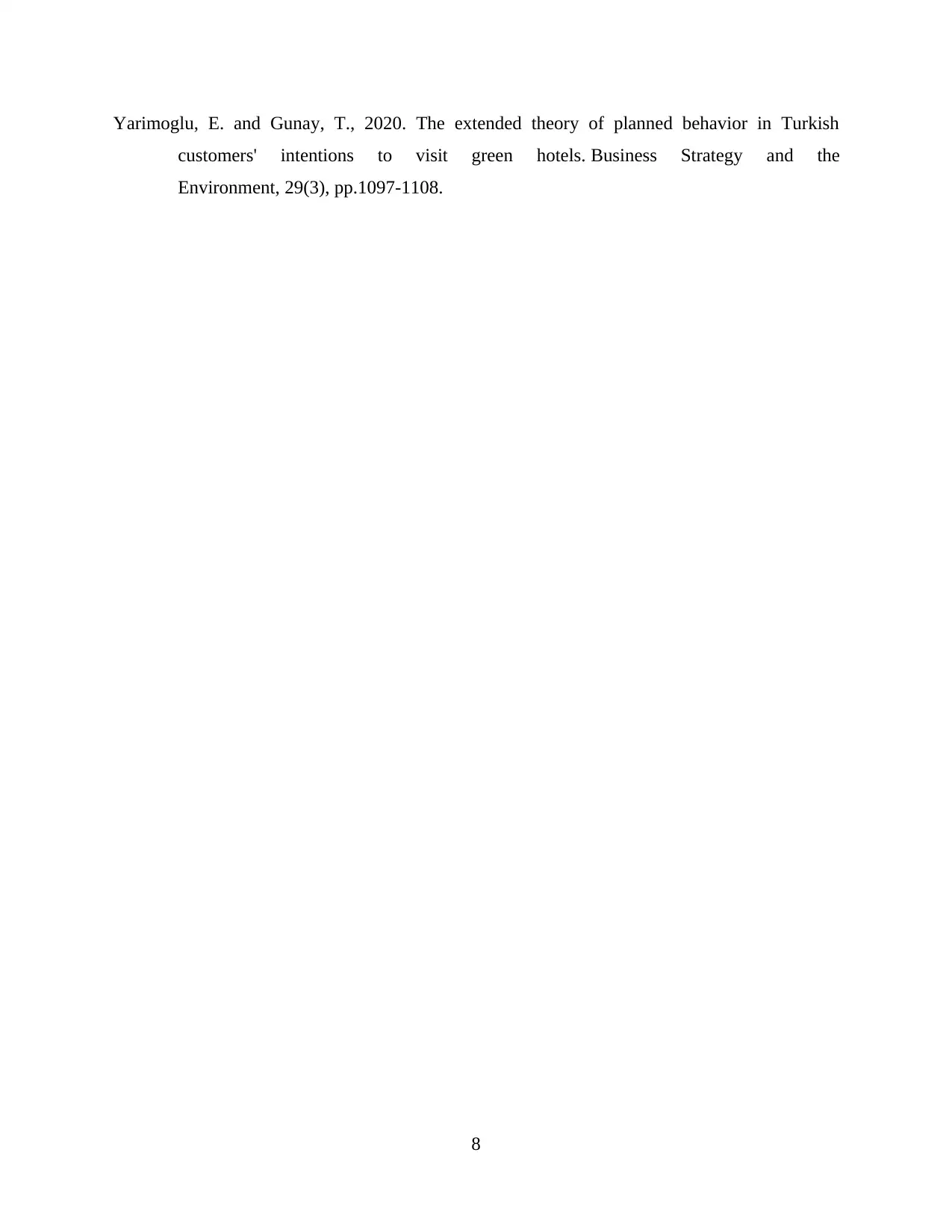
Yarimoglu, E. and Gunay, T., 2020. The extended theory of planned behavior in Turkish
customers' intentions to visit green hotels. Business Strategy and the
Environment, 29(3), pp.1097-1108.
8
customers' intentions to visit green hotels. Business Strategy and the
Environment, 29(3), pp.1097-1108.
8
1 out of 10
Related Documents
Your All-in-One AI-Powered Toolkit for Academic Success.
+13062052269
info@desklib.com
Available 24*7 on WhatsApp / Email
![[object Object]](/_next/static/media/star-bottom.7253800d.svg)
Unlock your academic potential
Copyright © 2020–2025 A2Z Services. All Rights Reserved. Developed and managed by ZUCOL.





